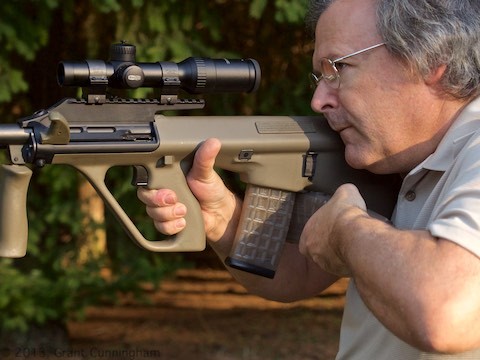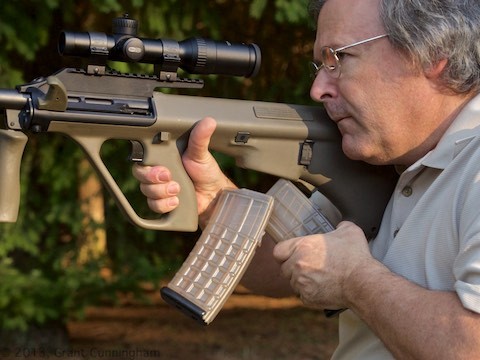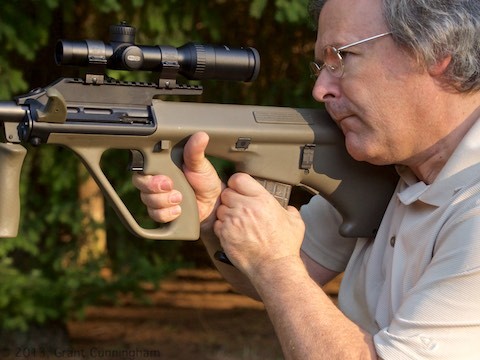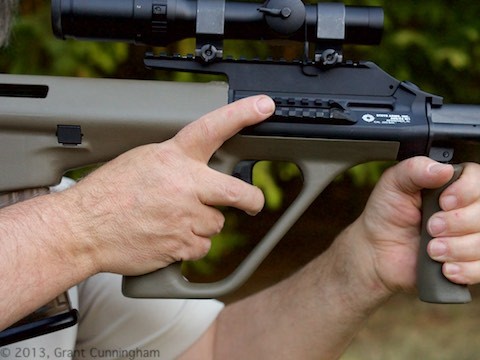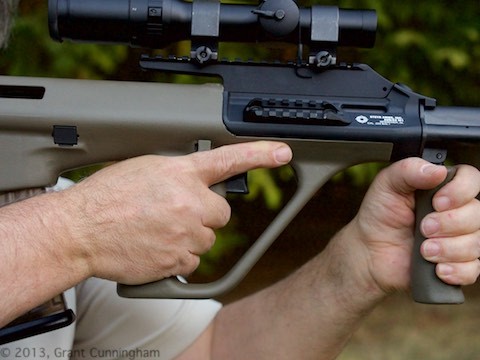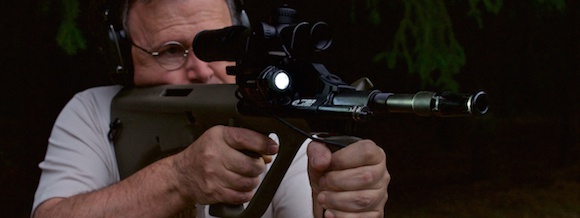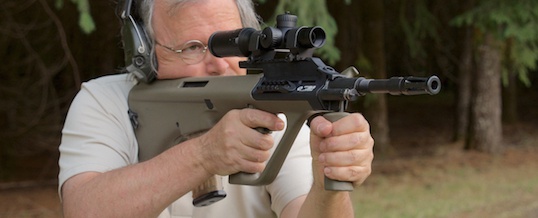
The Bullpup Rifle Experiment, Part 3: what did I learn about the Steyr AUG?
(If you’re coming in late, please read Part 1 and Part 2 of The Bullpup Experiment for some background on the project!)
While I got to play with several bullpups during the last few months, the vast majority of my hands-on experience was with the Steyr AUG A3 M1 model. As I noted in Part 1, I picked the AUG in part because it was the first — the original — modern bullpup rifle and really set the standard against which all other bullpup rifles would be judged. It made sense to start there and find out what made this type of rifle so unique; what made it special enough that other countries suddenly decided to hop on the bullpup bandwagon (with varying degrees of success)?
The AUG we have in this country is, in terms of appearance, not really any different than the AUG which is issued to militaries around the world. Inside, of course, it’s a different beast in one important way: the gun isn’t select fire and can’t be made into one. In terms of control placement, handling, and construction, though, it’s pretty much unchanged.
To start, the gun was completely reliable. This did not come as a shock; the AUG has a reputation for durability and reliability, and I experienced not so much as a hiccup during my use. I even fed it several hundred rounds of ammunition of dubious quality (some old mil-surp from an unidentified Spanish-speaking country) and it didn’t flinch. What’s more, I didn’t clean or lube the rifle when I received it and have been running it the entire time with whatever lubricant the factory used. One of these days I suppose I should take the thing apart and clean it, but I frankly don’t see the need.
(It should be pointed out that I’m not big on gun cleaning in general. To me it’s a little like going to the dentist: I do it only when I have to, and twice a year is more than enough!)
As I mentioned in Part 2, the trigger is heavy but fairly crisp. I didn’t have the chance to really benchrest the gun to see how that trigger affected my ability to shoot, but I can report that I did experience a couple of 5-round groups fired at 50 yards from a prone position that measured right at 3/4”. I’m still hoping to get a chance to really put the gun through its accuracy paces and find out if that’s a regularly achievable performance, but as a defensive tool that’s certainly acceptable (and with that mystery ammo, no less.)
I found the way to deal with the heavy trigger was to pay attention to what I’ve come to call “pre-compression”: apply pressure to the trigger so that the flesh of the finger has been fully compressed without moving the trigger, then press the trigger back swiftly and smoothly when you want the shot to break. A lot of the mushiness people feel, I think, is really their finger being squished against the trigger face, which isn’t moving because of its weight!
(I might add that this technique didn’t help at all with the Tavor triggers I tried. If you have one of those guns and haven’t yet replaced the trigger, you’re on your own.)
Magazine changes, one of the other supposed banes of the bullpup design, didn’t prove to be an issue at all. Yes, I had to adjust to the peculiarities of the bullpup design but it didn’t take long, and after that I found I could reload the AUG faster than I can an AK-type rifle — and surprisingly just about as fast as I can reload an AR-15.
Now I’ll admit that I’m not a top 3-gun competitor and that Jerry Miculek could just wipe the floor with me, but I’m a pretty fair hand with an AR. Despite my years of familiarity with the AR, after the aforementioned “break in” period I was able to prove to myself that there wasn’t a huge time difference between the two — the variance in either being greater than the difference between them.
The key, I found, is to leave the butt on the shoulder with the barrel parallel to the ground. This is greatly facilitated by the neutral weight balance; with my ARs, it’s tough to do because the weight of the barrel pivoting around my shooting hand continually pulls the butt up and off my shoulder. This is one of the reasons so many people point the muzzle of their AR up in the air, which allows the shoulder to support the rifle instead of the firing hand, or down at the ground — which allows the rifle to “hang” from the shooting hand.
With a bullpup, holding the muzzle up prevents the magazines from falling free and makes the angle of insertion awkward, while holding it down closes up the space where the magazine needs to go and makes it difficult to insert.
The solution is simply keeping the butt on the shoulder and holding the gun in a normal horizontal shooting position. This keeps the area where the magazine is located open for manipulation while still allowing the magazine to drop free.
(Selected frames from a continuous high-speed reload sequence; elapsed time between first and third frames is 6/10 of a second. Note the enhanced proprioception from having the magazine well between the shooting hand and the shoulder allows me to easily change magazines without needing to look at the gun.)
When you recognize the rifle is empty, grab a fresh magazine and do an AK-esque reload: use the new magazine to hit the mag release; the empty magazine will fall out of the rifle, at which time the new magazine is simply shoved into the mag well. At that point you can choose to release the bolt using the bolt release just above the magazine, or run the conveniently-located charging handle on the left front of the rifle.
Since I prefer to run the charging handle, whether using an AK, AR or FAL, this is what I chose to do with the AUG (most of the time; I did practice with the bolt release to be able to advise people who prefer that method even though I don’t advocate it.) Running an AR-15 charging handle is a problem because your face gets in the way — particularly if you have one of the short buttstocks. Running the AUG charging handle requires no moving of the gun or the head; in that respect it’s very much like an FN-FAL, which I appreciated. This is part of the reason my reloads with the AUG were about as fast as with the AR: I didn’t need to take the time to get my face out of the way of the charging handle!
As I mentioned in the last episode, I did have to adjust my non-standing shooting positions to account for the differences in the gun’s layout (which was the case with every bullpup I handled, though the vertical foregrip required different changes.) I often ended up using the front of the handguard as a replacement for a forearm, which actually worked out fairly well. Were I in charge of making the AUG in Austria, I’d curve the outside of the handguard and widen it just a bit to serve the purpose a little better.
I should point out that I have very short arms, and those people who were of larger stature were better able to employ the foregrip in all of the shooting positions.
As I’ve alluded, the general handling qualities of the AUG were quite good. I appreciated the neutral weight balance, the wide butt (with nicely rounded edges; the tiny, sharp collapsible buttstock on my CAR-15 is painful in comparison), and the charging handle which also served as an HK-esque bolt hold-open.
I’ve mentioned the vertical foregrip, which is one of the features I most wanted to try — especially since I’ve always eschewed them on the AR-15 (on which they now seem to have fallen out of favor.) I must admit I’m of two minds about the foregrip: on the one hand, I’m far more accustomed to a conventional forearm and found this to be a bit of an adjustment, especially in non-standing shooting positions; on the other, those bullpups I’ve shot that featured conventional forearms left me a little anxious about accidentally getting my support hand in front of the muzzle. The vertical foregrip certainly eliminates that problem, and while I’m still more partial to the common forearm pattern I’m quickly warming up to the foregrip.
I’ll say this about the foregrip: it certainly makes it easy to remove the barrel, which is a feature I really liked. Not only does removing the barrel make stowing the gun easier, it makes cleaning a snap (if, of course, you’re the type that cleans your guns!) It also makes holding the gun in a “close ready” position (butt off the shoulder, gun against your torso with the muzzle pointed down and to one side of your feet) significantly easier.
Did I find any issues with the design of the AUG? Of course. As I’ve pointed out before, there is no perfect gun; we just get used to working around any gun’s imperfections to the point that we no longer see them as such.
For me the biggest issue had to do with the safety. Well, not the safety per se but rather where it’s located; it’s a large crossbolt affair, located above the trigger. That’s the very spot where I’d normally put my finger to keep it off of the trigger but with the safety there, my finger has to go either above the safety button or below.
Here’s the problem: my hand is small enough that if I put my finger above the safety, my middle finger creeps up to the trigger (since the gun doesn’t have a trigger guard, just a handguard, the trigger is exposed to the entire shooting hand.) That sort of defeats the purpose of keeping my trigger finger off the trigger!
If I put my finger underneath of the safety, however, the strongly sloped side of the stock gives no place for the finger to actually rest and consequently it wants to stray directly onto the exposed trigger. In fact, in pictures or videos taken from the opposite side of the gun it looks like my trigger finger is on the trigger, even though it’s “in register” against the safety. Any startle or stumble which initiates a grasp reflex response would result in my finger sliding down and grabbing the trigger.
I experimented for a month or so with resting my finger on the safety, which proved to be a bad approach to the problem. The crossbolt is easily disengaged (good for shooting quickly), which means that almost any muscle contraction of my hand released the safety — leaving the trigger finger resting on that steep sloped receiver, which then guides it straight down onto the off-safe trigger. That’s worse than either of the other options.
Further experimentation has lead me to settle on curling the finger around the safety – over the top and down. That seems to be the most workable solution for me.
It must be pointed out that not everyone shared my experience. Those who had larger hands than I do had no issue; they were able to put their trigger finger high on the receiver, actually touching the back of the accessory rail, which solved the problem. It was those people who, like me, had small hands who had an issue. Even so, I think it’s important enough that Steyr should address it — and could do so at very little cost. A small “hump” in the plastic stock, in front of and just below the safety, would give a bit of a shelf on which the trigger finger could rest and would sufficiently address the problem. (Again, I don’t mind the crossbolt safety at all; it’s the shape of the stock in that area which is the problem.)
As with many other bullpups, working with the sling points was more complicated than conventional rifles. Steyr places the front sling attachment point in front of the optic rail using a pushbutton quick release. This centerline location, combined with a rear sling swivel that can be moved to either side of the buttstock in about three seconds, makes it easy to use the sling on either the right or left side, but can get in the way of the optics. I learned to sweep the sling aside as I shouldered the rifle, which seemed to do the trick.
I have no suggestions for a better alternative, though, because most bullpups suffer from a lack of good sling points. This points out the necessity of making some adaptations to any new firearm. As I experiment with slings and their use on the bullpup rifle I’m finding myself starting from scratch: identifying the plausible uses for a sling in private sector self defense and let those guide how I configure everything. I’ll probably have more to say later, as slings are an area where we often let our attraction to cool gear override our rational thought. (Slings in the world of civilian self defense serve a different purpose than they do for the soldier, and are consequently of less immediate concern.)
Those nitpicks aside, I do like the Steyr AUG A3 M1 (boy, is that a mouthful.) Is it a “better” gun than some of the other bullpups? I hate to sound like I’m equivocating, but for some people yes, for others no; that’s the case with many firearms, isn’t it? The bullpup arena is full of very idiosyncratic guns, at least compared to the more common rifles we’re all used to. Each of them has a slightly different approach to dealing with the design issues the bullpup concept brings; after reading about my experience, I hope you’ll have a better feeling for how Steyr’s version might serve your needs.
– Grant Cunningham
- Posted by Grant Cunningham
- On October 6, 2015


